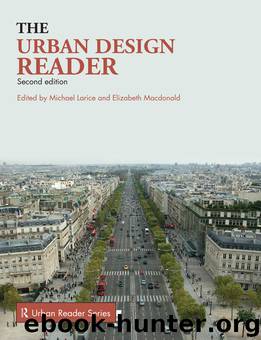The Urban Design Reader by Unknown

Author:Unknown
Language: eng
Format: epub
ISBN: 1180994
Publisher: Routledge
“Themes of Postmodern Urbanism”
from Postmodern Urbanism (1996)
Nan Ellin
Editors’ Introduction
The postmodern era of the late twentieth century is a highly debated topic among academics, not just as historic periodization but also as an identifiable design movement (which many say continues today). To some chroniclers, postmodernism is the cultural expression associated with a very specific period of time beginning in the 1950s, through the turn of the century. The cultural work of this period includes a wide range of fields, including: literature, linguistics, philosophy, sociology, religion, history, music, and anthropology. Postmodern social movements and characteristics are well known: feminism, post-structuralism, pluralism, cultural relativism, and the end of paradigmatic meta-narratives. The postmodern here refers to a continuing critique of Enlightenment attitudes that challenge dominant structures of modernism, science and theology. To others, such as Frederic Jameson and David Harvey, the postmodern is synonymous with the period of late capitalism, often associated with consumer perspectives, globalization, neo-Marxism, and multinational corporate interests.
Within the built environment professions, the postmodern period is associated with both discontentment and rejection of modern design and planning practices – but also a design movement that championed improved communication of design intentions, humor-irony-camp-kitsch, and the rebirth of place-based contextualism. Some of the discontented include a list of now-famous authors and designers associated with the history of urban design, including: Jane Jacobs, Christopher Alexander, Robert Venturi and Denise Scott Brown, Colin Rowe, Edward Relph, the CNU, and Douglas Kelbaugh (all represented in this volume). With reference to the built environment professions, postmodern debates continue and become intensified, as many practitioners seek to distance themselves from comparisons and connotations to built works from the early years of the movement, including some very shallow and ill-appreciated projects, for example, the Piazza d’Italia in New Orleans, or any number of dated office buildings, museums, or libraries with thinly applied decoration. The great chronicler of this movement within the design professions is Charles Jencks in his 1977 publication, The Language of Postmodern Architecture (New York: Rizzoli).
In a literary tour-de-force, Nan Ellin’s Postmodern Urbanism has become one of the more important texts describing the postmodern period. What Jencks does for postmodern architecture, Ellin does for postmodern urban design and urbanism. Describing the key elements of the postmodern reflex, as well as its European and Anglo-American branches, she provides a comprehensive synthesis of a complex history, which she manages to make highly accessible. In early chapters she reviews the various design characteristics and larger theoretical attributes of the postmodern period of the 1960s to 1990s, while in later chapters she situates postmodern urban design within the professions, provides objective critique, and looks to the future. The central chapter in which she describes the themes, critiques, and outcomes of postmodern urbanism is presented here in an abridged form, providing the key lessons from the beginning and end of the chapter.
For Ellin, “postmodern urbanism” is defined relative to the previous modernism: first, by a return to historicism and a renewed search for urbanity; second, by a new emphasis on contextualism, regionalism,
Download
This site does not store any files on its server. We only index and link to content provided by other sites. Please contact the content providers to delete copyright contents if any and email us, we'll remove relevant links or contents immediately.
Kathy Andrews Collection by Kathy Andrews(11716)
The remains of the day by Kazuo Ishiguro(8801)
Paper Towns by Green John(5076)
Spare by Prince Harry The Duke of Sussex(5061)
The Body: A Guide for Occupants by Bill Bryson(4963)
Industrial Automation from Scratch: A hands-on guide to using sensors, actuators, PLCs, HMIs, and SCADA to automate industrial processes by Olushola Akande(4940)
Machine Learning at Scale with H2O by Gregory Keys | David Whiting(4135)
Be in a Treehouse by Pete Nelson(3930)
Never by Ken Follett(3773)
Harry Potter and the Goblet Of Fire by J.K. Rowling(3764)
Goodbye Paradise(3720)
Into Thin Air by Jon Krakauer(3298)
The Remains of the Day by Kazuo Ishiguro(3286)
The Cellar by Natasha Preston(3253)
The Genius of Japanese Carpentry by Azby Brown(3214)
Fairy Tale by Stephen King(3205)
120 Days of Sodom by Marquis de Sade(3167)
Drawing Shortcuts: Developing Quick Drawing Skills Using Today's Technology by Leggitt Jim(2988)
The Man Who Died Twice by Richard Osman(2985)
